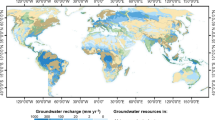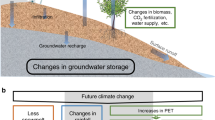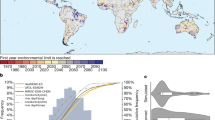Abstract
Groundwater constitutes a critical component of our water resources. Widespread groundwater level declines have occurred in the USA over recent decades, including in regions not typically considered water stressed, such as areas of the Northwest and mid-Atlantic Coast. This loss of water storage reflects extraction rates that exceed natural recharge and capture. Here, we explore recent changes in the groundwater levels of deep aquifers from wells across the USA, and their relation to indices of interannual to decadal climate variability and to annual precipitation. We show that groundwater level changes correspond to selected global climate variations. Although climate-induced variations of deep aquifer natural recharge are expected to have multi-year time lags, we find that deep groundwater levels respond to climate over timescales of less than one year. In irrigated areas, the annual response to local precipitation in the deepest wells may reflect climate-induced pumping variability. An understanding of how the human response to drought through pumping leads to deep groundwater changes is critical to manage the impacts of interannual to decadal and longer climate variability on the nation’s water resources.
This is a preview of subscription content, access via your institution
Access options
Access Nature and 54 other Nature Portfolio journals
Get Nature+, our best-value online-access subscription
$29.99 / 30 days
cancel any time
Subscribe to this journal
Receive 12 print issues and online access
$259.00 per year
only $21.58 per issue
Buy this article
- Purchase on Springer Link
- Instant access to full article PDF
Prices may be subject to local taxes which are calculated during checkout



Similar content being viewed by others
References
Döll, P. et al. Impact of water withdrawals from groundwater and surface water on continental water storage variations. J. Geodyn. 59–60, 143–156 (2012).
Famiglietti, J. S. The global groundwater crisis. Nat. Clim. Change 4, 945–948 (2014).
Maupin, M. et al. Estimated Use of Water in the United States in 2010: USGS Circular 1405 (US Geological Survey, 2014).
Siebert, S. et al. Groundwater use for irrigation—a global inventory. Hydrol. Earth Syst. Sci. 14, 1863–1880 (2010).
Scanlon, B. R. et al. Groundwater depletion and sustainability of irrigation in the US High Plains and Central Valley. Proc. Natl Acad. Sci. USA 109, 9320–9325 (2012).
Konikow, L. F. Groundwater Depletion in the United States (1900–2008) Scientific Investigations Report 2013–5079 (US Geological Survey, 2013).
Scanlon, B. R., Reedy, R. C., Gates, J. B. & Gowda, P. H. Impact of agroecosystems on groundwater resources in the Central High Plains, USA. Agric. Ecosyst. Environ. 139, 700–713 (2010).
Ho, M. et al. America’s Water: agricultural water demands and the response of groundwater. Geophys. Res. Lett. 43, 7546–7555 (2016).
Fan, Y., Li, H. & Miguez-Macho, G. Global patterns of groundwater table depth. Science 339, 940–943 (2013).
USGS-NWIS USGS Groundwater Levels for the Nation (Accessed 2016).
Clark, B., Hart, R. & Gurdak, J. Groundwater Availability of the Mississippi Embayment Professional Paper 1785 (US Geological Survey, 2011).
Farm and Ranch Irrigation Survey (USDA, 2013).
Green, T. R. et al. Beneath the surface of global change: impacts of climate change on groundwater. J. Hydrol. 405, 532–560 (2011).
Earman, S. & Dettinger, M. Potential impacts of climate change on groundwater resources—a global review. J. Wat. Clim. Change 2, 213–229 (2011).
Whittemore, D. O., Butler, J. J. Jr & Wilson, B. B. Assessing the major drivers of water-level declines: new insights into the future of heavily stressed aquifers. Hydrol. Sci. J. 61, 134–145 (2016).
Kuss, A. J. M. & Gurdak, J. J. Groundwater level response in U.S. principal aquifers to ENSO, NAO, PDO, and AMO. J. Hydrol. 519, 1939–1952 (2014).
Taylor, R. et al. Ground water and climate change. Nat. Clim. Change 3, 322–329 (2013).
Hanson, R. T. & Dettinger, M. D. Ground water/surface water responses to global climate simulations, Santa Clara–Calleguas Basin, Ventura, CA. J. Am. Wat. Resour. Assoc. 41, 517–536 (2005).
Holman, I. P., Rivas-Casado, M., Bloomfield, J. P. & Gurdak, J. J. Identifying non-stationary groundwater level response to North Atlantic ocean-atmosphere teleconnection patterns using wavelet coherence. Hydrogeol. J. 19, 1269–1278 (2011).
Bakker, M. & Nieber, J. L. Damping of sinusoidal surface flux fluctuations with soil depth. Vadose Zone J. 8, 119–126 (2009).
Dickinson, J. E., Ferré, T. P. A., Bakker, M. & Crompton, B. A screening tool for delineating subregions of steady recharge within groundwater models. Vadose Zone J. http://dx.doi.org/10.2136/vzj2013.10.0184 (2014).
Chen, Z., Grasby, S. E. & Osadetz, K. G. Relation between climate variability and groundwater levels in the upper carbonate aquifer, southern Manitoba, Canada. J. Hydrol. 290, 43–62 (2004).
Scanlon, B. R., Reedy, R. C., Stonestrom, D. A., Prudic, D. E. & Dennehy, K. F. Impact of land use and land cover change on groundwater recharge and quality in the southwestern US. Glob. Change Biol. 11, 1577–1593 (2005).
Gurdak, J. J. et al. Climate variability controls on unsaturated water and chemical movement, High Plains Aquifer, USA. Vadose Zone J. 6, 533–547 (2007).
Van Loon, A. F. et al. Drought in the anthropocene. Nat. Geosci. 9, 89–91 (2016).
Condon, L. & Maxwell, R. Feedbacks between managed irrigation and water availability: diagnosing temporal and spatial patterns using an integrated hydrologic model. Wat. Resour. Res. 50, 2600–2616 (2014).
Healy, R. W. & Cook, P. G. Using groundwater levels to estimate recharge. Hydrogeol. J. 10, 91–109 (2002).
Sophocleous, M. On understanding and predicting groundwater response time. Ground Water 50, 528–540 (2012).
Bredehoeft, J. D. Monitoring regional groundwater extraction: the problem. Ground Water 49, 808–814 (2011).
Hanson, R. T., Dettinger, M. D. & Newhouse, M. W. Relations between climatic variability and hydrologic time series from four alluvial basins across the southwestern United States. Hydrogeol. J. 14, 1122–1146 (2006).
Climate Monitoring Teleconnections (NOAA, 2015); http://www.ncdc.noaa.gov/teleconnections
Maurer, E., Wood, A., Adam, J., Lettenmaier, D. P. & Nijssen, B. A long-term hydrologically based dataset of land surface fluxes and states for the conterminous United States. J. Clim. 15, 3237–3251 (2002).
Kansas Irrigation Water Use (Kansas Department of Agriculture, USGS, Kansas Water Office, 2013).
Akuoko-Asibey, A., Nkemdirim, L. C. & Draper, D. L. The impacts of climatic variables on seasonal water consumption in Calgary, Alberta. Can. Wat. Resour. J. 18, 107–116 (1993).
Granger, C. Investigating causal relations by econometric models and cross-spectral methods. Econometrica 37, 424–438 (1969).
Loáiciga, H. Climate change and ground water. Ann. Assoc. Am. Geogr. 93, 37–41 (2003).
Ferguson, I. M. & Maxwell, R. M. Human impacts on terrestrial hydrology: climate change versus pumping and irrigation. Environ. Res. Lett. 7, 044022 (2012).
Döll, P. Vulnerability to the impact of climate change on renewable groundwater resources: a global-scale assessment. Environ. Res. Lett. 4, 035006 (2009).
Hirsch, R. M., Slack, J. R. & US Geological A nonparametric trend test for seasonal data with serial dependence. Wat. Resour. Res. 20, 727–732 (1984).
Helsel, D. & Hirsch, R. Statistical Methods in Water Resources (Elsevier, 1992).
Murtagh, F. & Legendre, P. Ward’s hierarchical agglomerative clustering method: which algorithms implement ward’s criterion? J. Classif. 31, 274–295 (2014).
Torrence, C. & Compo, G. P. A practical guide to wavelet analysis. Bull. Am. Meteorol. Soc. 79, 61–78 (1998).
Rousseeuw, P. Silhouettes: a graphical aid to the interpretation and validation of cluster analysis. J. Comput. Appl. Math. 20, 53–65 (1987).
Lütkepohl, H. New Introduction to Multiple Time Series Analysis (Springer, 2005).
Acknowledgements
Support for this work comes from NSF Water Sustainability and Climate Project #1360446, the Columbia Earth Institute Postdoctoral Fellowship Program, and the University of Chicago 1896 Pilot Project. We thank K. Mankoff for help with data collection and preprocessing. The data described in this paper are available from the USGS and NOAA websites.
Author information
Authors and Affiliations
Contributions
T.A.R. and U.L. contributed to the analysis and writing of this article.
Corresponding author
Ethics declarations
Competing interests
The authors declare no competing financial interests.
Supplementary information
Supplementary Information
Supplementary Information (PDF 1094 kb)
Rights and permissions
About this article
Cite this article
Russo, T., Lall, U. Depletion and response of deep groundwater to climate-induced pumping variability. Nature Geosci 10, 105–108 (2017). https://doi.org/10.1038/ngeo2883
Received:
Accepted:
Published:
Issue Date:
DOI: https://doi.org/10.1038/ngeo2883
This article is cited by
-
Drought Atlas of India, 1901–2020
Scientific Data (2024)
-
Rapid groundwater decline and some cases of recovery in aquifers globally
Nature (2024)
-
Moving from measurement to governance of shared groundwater resources
Nature Water (2023)
-
Statistical analysis of rainfall and groundwater interaction in Bhadra catchment
Environment, Development and Sustainability (2023)
-
Groundwater level declines in Tianjin, North China: climatic variations and human activities
Environment, Development and Sustainability (2023)



